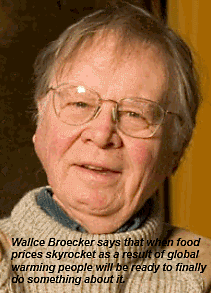|
News & Views item - August 2012 |
![]() Were you the First to Warn About Anthropogenic Global Warming in a Scientific
Paper? (August 25, 2012)
Were you the First to Warn About Anthropogenic Global Warming in a Scientific
Paper? (August 25, 2012)
 Freelance
Writer Steven A. Edwards writing on August 16, 2012 for the American Association
for the Advancement of Science's MemberCentral (AAASMC) asked that question of
Wallace Broecker about his August 8, 1975 paper in Science “Are We on
the Brink of a Pronounced Global Warming?” Professor Broecker, 80, who is
Newberry Professor in the Department of Earth and Environmental Sciences at
Columbia University demurred: "No, no... I once offered my students a $200
reward if they could find a previous reference to global warming in the
scientific literature. The reward was never claimed, but a postdoc found a
reference in a 1958 Indiana newspaper account of two southern California
scientists who were warning about industrialization causing climate change. The
scientists weren’t named, but reading between the lines, they must have been
Roger Revelle and Charles Keeling (both from the Scripps Institute of
Oceanography). Keeling started the CO2 readings at Mauna Loa that are
always cited. I think Keeling should be the “father of global warming.”
Freelance
Writer Steven A. Edwards writing on August 16, 2012 for the American Association
for the Advancement of Science's MemberCentral (AAASMC) asked that question of
Wallace Broecker about his August 8, 1975 paper in Science “Are We on
the Brink of a Pronounced Global Warming?” Professor Broecker, 80, who is
Newberry Professor in the Department of Earth and Environmental Sciences at
Columbia University demurred: "No, no... I once offered my students a $200
reward if they could find a previous reference to global warming in the
scientific literature. The reward was never claimed, but a postdoc found a
reference in a 1958 Indiana newspaper account of two southern California
scientists who were warning about industrialization causing climate change. The
scientists weren’t named, but reading between the lines, they must have been
Roger Revelle and Charles Keeling (both from the Scripps Institute of
Oceanography). Keeling started the CO2 readings at Mauna Loa that are
always cited. I think Keeling should be the “father of global warming.”
Here are a couple of additional excerpts from the interview:
AAASMC: In your [1975] paper, you say that only
carbon dioxide of atmospheric gasses can be demonstrated to be significant for
climate change. Is this still true? How about methane, for example?
Broecker: Well, methane, sure. But methane and most other things that we put out into the atmosphere don’t last for very long. The CO2 that we put out today will last for centuries. The ocean will eventually take it out, but that will take a thousand years. So the effects will be with us for a very long time.
AAASMC: What do you think should or can be done to
ameliorate the effects of global warming going forward?
Broecker: I’m in favor of air capture, not just sequestering carbon dioxide at power plants, but actually sucking it out of the air and burying it. Klaus Lackner at Columbia has devised a system for doing this with membranes. The membranes love to bind CO2 when they’re dry, but then it can easily be washed out (Sometimes called “artificial trees,” Lackner’s technology can reportedly remove about 1000 times more carbon dioxide from the air than could a real tree of the same size).
_________________________
Note added September 4, 2012: Imre Bokor points out that in the 1962 fourteenth edition of the Encyclopaedia Britannica (volume 1, p.46) the entry entitled "Air" notes:
Carbon dioxide in the air reduces the loss of heat by
infrared radiation
from the earth. The widespread burning of fossil fuel (e.g. coal and oil)
increased the carbon dioxide content of the air by about 12% during the
first half of the 20th century. This, in turn, caused an increase in the
average temperature of the earth of 1.1degrees C during the same period.
The bibliography for the article is listed as:
GP Kuiper (ed) Atmospheres of the Earth and Planets
(1949)
TF Malone (ed) Compendium of Meteorology, esp."The Com[position of the Air"
by E.Glueckauf (1951)
GN Plass Carbon Dioxide and the Climate American Scientist Vol 44 302--316
(1956)